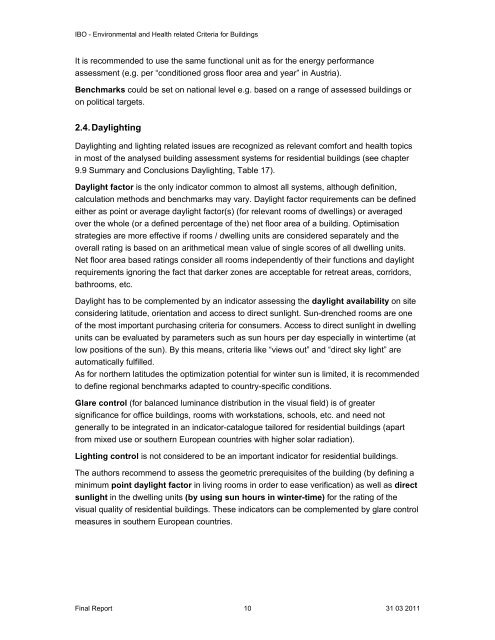Environmental and health related criteria for buildings - ANEC
Environmental and health related criteria for buildings - ANEC
Environmental and health related criteria for buildings - ANEC
You also want an ePaper? Increase the reach of your titles
YUMPU automatically turns print PDFs into web optimized ePapers that Google loves.
IBO - <strong>Environmental</strong> <strong>and</strong> Health <strong>related</strong> Criteria <strong>for</strong> Buildings<br />
It is recommended to use the same functional unit as <strong>for</strong> the energy per<strong>for</strong>mance<br />
assessment (e.g. per “conditioned gross floor area <strong>and</strong> year” in Austria).<br />
Benchmarks could be set on national level e.g. based on a range of assessed <strong>buildings</strong> or<br />
on political targets.<br />
2.4. Daylighting<br />
Daylighting <strong>and</strong> lighting <strong>related</strong> issues are recognized as relevant com<strong>for</strong>t <strong>and</strong> <strong>health</strong> topics<br />
in most of the analysed building assessment systems <strong>for</strong> residential <strong>buildings</strong> (see chapter<br />
9.9 Summary <strong>and</strong> Conclusions Daylighting, Table 17).<br />
Daylight factor is the only indicator common to almost all systems, although definition,<br />
calculation methods <strong>and</strong> benchmarks may vary. Daylight factor requirements can be defined<br />
either as point or average daylight factor(s) (<strong>for</strong> relevant rooms of dwellings) or averaged<br />
over the whole (or a defined percentage of the) net floor area of a building. Optimisation<br />
strategies are more effective if rooms / dwelling units are considered separately <strong>and</strong> the<br />
overall rating is based on an arithmetical mean value of single scores of all dwelling units.<br />
Net floor area based ratings consider all rooms independently of their functions <strong>and</strong> daylight<br />
requirements ignoring the fact that darker zones are acceptable <strong>for</strong> retreat areas, corridors,<br />
bathrooms, etc.<br />
Daylight has to be complemented by an indicator assessing the daylight availability on site<br />
considering latitude, orientation <strong>and</strong> access to direct sunlight. Sun-drenched rooms are one<br />
of the most important purchasing <strong>criteria</strong> <strong>for</strong> consumers. Access to direct sunlight in dwelling<br />
units can be evaluated by parameters such as sun hours per day especially in wintertime (at<br />
low positions of the sun). By this means, <strong>criteria</strong> like “views out” <strong>and</strong> “direct sky light” are<br />
automatically fulfilled.<br />
As <strong>for</strong> northern latitudes the optimization potential <strong>for</strong> winter sun is limited, it is recommended<br />
to define regional benchmarks adapted to country-specific conditions.<br />
Glare control (<strong>for</strong> balanced luminance distribution in the visual field) is of greater<br />
significance <strong>for</strong> office <strong>buildings</strong>, rooms with workstations, schools, etc. <strong>and</strong> need not<br />
generally to be integrated in an indicator-catalogue tailored <strong>for</strong> residential <strong>buildings</strong> (apart<br />
from mixed use or southern European countries with higher solar radiation).<br />
Lighting control is not considered to be an important indicator <strong>for</strong> residential <strong>buildings</strong>.<br />
The authors recommend to assess the geometric prerequisites of the building (by defining a<br />
minimum point daylight factor in living rooms in order to ease verification) as well as direct<br />
sunlight in the dwelling units (by using sun hours in winter-time) <strong>for</strong> the rating of the<br />
visual quality of residential <strong>buildings</strong>. These indicators can be complemented by glare control<br />
measures in southern European countries.<br />
Final Report 10 31 03 2011
















